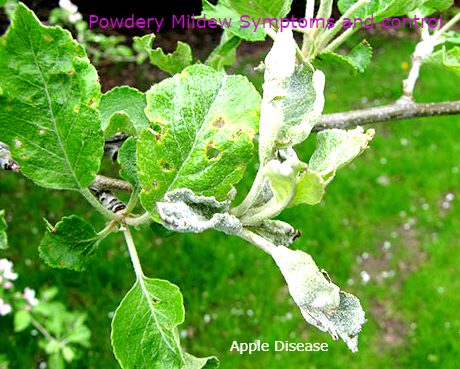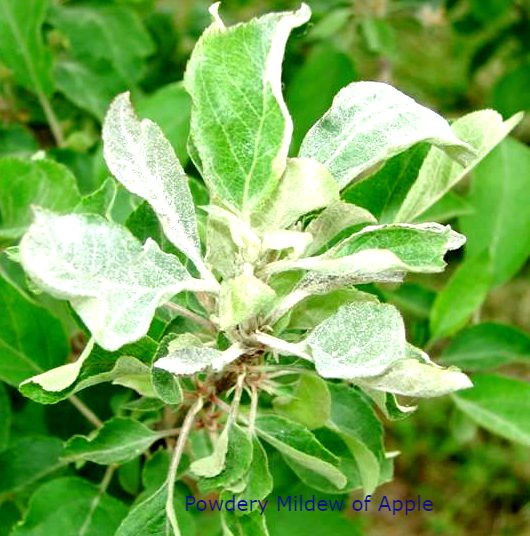Powdery Mildew of Apple
Powdery mildew of apple fruit, caused by the fungus (Podosphaera leucotricha) forms a solid white fungus growth (mycelium) on the host plant tissue and affects. The Powdery mildew of apple causes monetary misfortunes by lessening tree creation, blossom bud, and organic product quality. The powdery mildew of apple produces indications in beginning phases, leaves, blooms, and organic products. By and large, indications are most noticeable on the leaves and natural products. Discretionary infections and natural item pollution can oblige by foliar fungicide applications. In commercial lands, fungicides are used to control Powdery Mildew of apple Disease, as well as other apple infections.
Mildew Symptoms on Tree Leaves

Overwintering disorders in slow flower and shoot buds inoculate the following season. In the spring, when flowers begin to expand, the creature assumes control of the fem-like, green tissue as it emerges. These infected “placard leaves” have a silvery appearance and may exhibit defoliation, impede growth, and erode the soil. In the near future, as the season continues to advance. The important powdery mildew of apple disease creates inoculum on flag shoots, which causes optional contaminations on leaves, flowers, and organic products. Rapidly infecting trees become debilitated and are vulnerable to secondary pathogens.
At the peak of summer, the mycelium obscures the growth of diverse brown fruiting bodies (ascocarps). Instead of necessary illnesses, the leaf is infested as it emerges from the bud. Possible infections occur when spores carried by the wind land on young, expanding leaves. Mycelium and spore-based parasitic populations appear as white, felt-like patches.
Typically, powdery mildew infections of apples first appear on the lower leaf surface. Greensick patches may also be detected on the upper leaf surface. It is possible for longitudinally contaminated leaves to become twisted, wrinkly, or collapsed. As the infection progresses, infected tissues have the fine, silvery look typical of fine fungi. As the organic food grows, adulterants on the bloom depository or the young natural product will induce netlike russeting and staining. Additionally, organic items might be twisted and additionally influenced. Mold reduces both the quantity and quality of apples.
Powdery Mildew of apple Disease Cycle
The prior year was contaminated by overwintering mycelium in dormant flowers and shoot buds. In the spring, the infected buds awaken from their dormancy and the organism continues development, infecting the new shoots and leaf tissue. These critical infections are transmitted by conidiophores and dispersed by the wind by agamic conidia. Conidia will germinate at high relative humidity levels. Between 10 and 25 degrees Celsius; unlike the majority of foliar parasitic bacteria, leaf wetness inhibits illness. Young leaves are defenseless and secure as they mature.
Mold regions generally first appear as white, felt-like spots on the leaf’s lower surface. Conidia form hyphal outgrowths, which traverse the leaf surface, expand, and then level to form appressoria. These structures release proteins that allow infectious contamination particles to penetrate the plant’s epidermal cells and then multiply to form haustoria.
Late Season Growth
Haustoria are unique organs formed within living plant cells that absorb nutrients and serve as growth anchors. As the mold region expands or opportunistic disease cause novel settlement arrangements, the contamination cycle (hyphal outgrowth > appressorium > infection stake > haustorium) is repeated until there is no longer any accessible vulnerable tissue. Late-season growth could result in an unanticipated increase in mold growth. In addition to contributing to rapid inoculum development, optional disease cycles are responsible for contaminating horizontal and terminal buds that will carry the plant through the winter.
Essential contaminations in flower buds can produce conidia after the conclusion of the grouping. The period of apple development is when the flower cluster disperses and begins to separate while flower buds remain together. Typically, contaminated buds open later than healthy ones, ensuring the existence of vulnerable tissue for the growth to invade. From three weeks before to three weeks after the bloom, a secondary illness of the bloom container occurs. Contaminated repositories may shrink and fail to produce a natural product, or they may expand and produce a natural product; this includes stain, rust, predominance, and twist.
Powdery Mildew of Apple Disease Management
Utilizing less vulnerable apple varieties may be the most effective strategy for preventing accumulation. These cultivars include Jon Free, Prima, and Undertake; however, they are not widely cultivated. Apple cultivars are available that display consistent resistance to mold and require only minimal management under strong disease pressure. Establishing cultivars with a degree of resistance to certain common apple diseases can reduce the number of fungicide treatments and the total cost of the spray program during each growing season. Infection resistance has less of an impact on cultivar selection than the business offer, organic product features, attractiveness, and fertilizer attributes.
In a plantation, growers typically interplant cultivars with varying susceptibilities. Essential pollutants can be limited by removing essential inoculum sources. Note any brighter terminal shoots and remove them in the winter or late winter. Sadly, this is tough to accomplish. Evacuation of inoculum by pruning would be labor intensive and may disturb tree-structure development, particularly in vast commercial plantations. The complete removal of this type of inoculum is not financially feasible. The ideal candidate for this regulated method is small, young plantations with low levels of critical pathogens per tree.
Powdery Mildew of Apple Chemical Control
In addition to inorganics (sulfur), sterol-inhibitors (fenbuconazole & myclobutanil), and strobilurins, a variety of mixes are registered worldwide for the control of mold (trifloxystrobin & kresoxim-methyl). These can provide effective control, but producers should not rely just on one kind of fungicide. When the environment permits, cultivators should pivot or replace with different techniques of activity gathers, employ multi-site fungicides (sulfur) occasionally of generally safe, and sow more vulnerable cultivars. Benzimidazoles had an effect against accumulation, but their utility in the powdery mildew of apple disease executive\’s program was diminished due to the unavoidable advancement of obstruction in Venturia deficiencies.
Green oils, hydrocarbons, and organic mixes produced by Bacillus strains are also available, but their efficacy is somewhat debatable. The inability to add pre-sprout splashes is one of the most common mistakes made by producers in the molds of CEOs. When P. leucotricha begins growth in the spring, massive quantities of conidia are produced by uncontrolled auxiliary cycles. These agamic spores contaminate solid flower and shoot buds, which serve as the essential source of inoculum the next year. Control is difficult to achieve during the growing season if it has been abandoned from the start. During dry conditions, when other apple diseases are unable to thrive, growers may be tempted to relax their watering regimens; however, mold thrives in dry areas, thus vigilance is required.

